Category: Stories
Serving our Community

Many know Spice Bridge as home to our Food Business Incubator where people can come and experience food from around the world all while supporting immigrant and refugee chefs in launching their businesses. But did you know about our Community Meals program? Each week, Spice Bridge chefs cook up hundreds of meals that are then delivered to food insecure community members in need. Our Community Meal program is double the impact –culturally-appropriate meals are provided to those in need at no cost and the local food economy is supported by purchasing meals from our start-up BIPOC and immigrant/refugee chefs. Community supporting community.
Thanks to grant funds from the Washington State Department of Agriculture (WSDA) Food Assistance Program and a partnership with Seattle Good Business Network’s Good Food Kitchen Network, Spice Bridge chefs are cooking up to 350 meals each week. Our community partners, such as SHAG and International Rescue Committee (IRC), help ensure meals are delivered directly to the community’s doorstep. SHAG home-delivers the meals to seniors while providing a check-in during a time of isolation. IRC has ensured delivery of halal meals to arriving Afghan refugees in transitional housing—providing the comfort of familiar dishes in a new home.
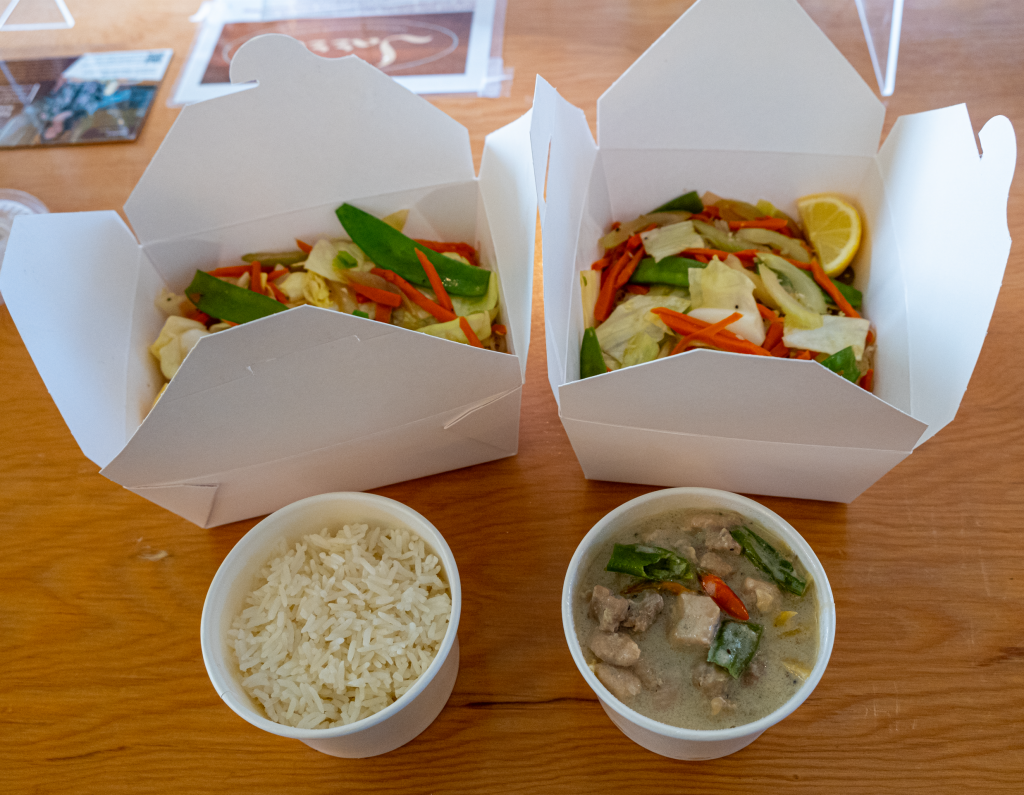
COVID-19 has exacerbated food insecurity in our communities. We are committed to improving the emergency food system, empowering the local community, and connecting those in need to multiple resources. Stay tuned for more updates this year as we expand this program, explore more partnerships, and connect with more food insecure individuals in our community.
Meet Theary Cambodian Foods Owner Theary Ngeth
We’re excited to introduce you to the vendors who offer cuisines from around the world at Spice Bridge! Today we’d like for you to meet the owner of Theary Cambodian Foods.
Theary Ngeth launched Theary Cambodian Foods in October to provide comfort and connection for her fellow Cambodians, and to preserve and share her cultural food traditions.
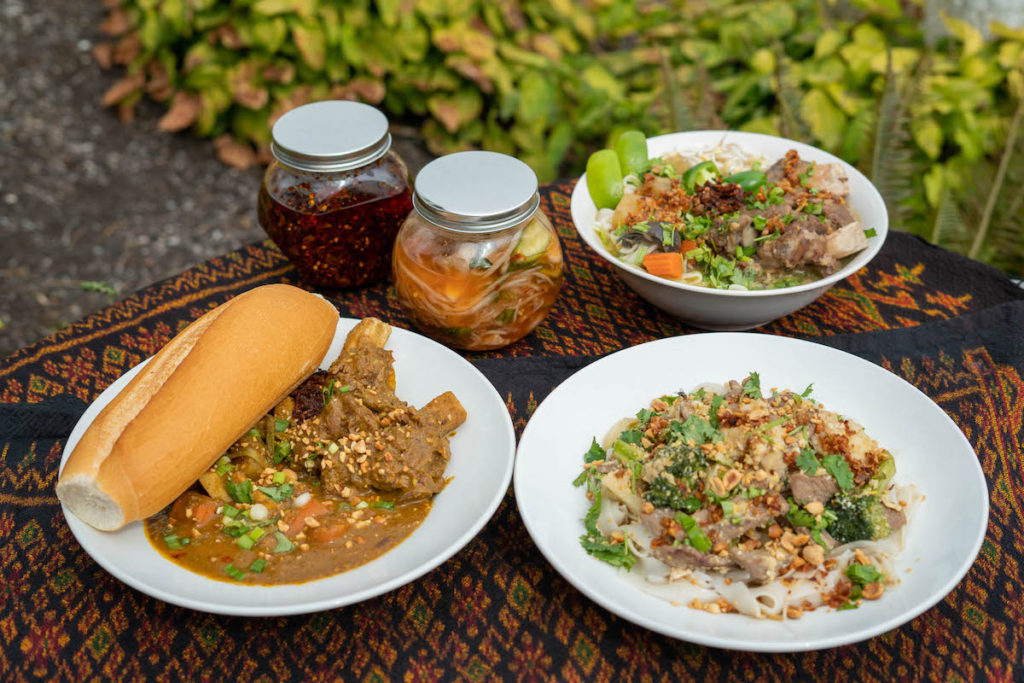
When Theary was 5 years old, she and her family escaped the Khmer Rouge on foot, making a dangerous journey through the jungle from Cambodia to Thailand. They were among thousands of Cambodians who fled genocide, survived brutal conditions in refugee camps, and eventually resettled in the United States. These refugees endured many losses, including important parts of their culinary heritage.
“So many Cambodian recipes, traditionally passed down orally from parents to children, went to the grave during the Khmer Rouge," Theary said. Her mother and other survivors kept many Cambodian cooking traditions alive, but Theary sees them fading as her parents' generation passes away.
"We are losing our authentic flavors and our techniques, because elders hold the knowledge of how our dishes are made and how exactly they should taste. You can't learn this from a book or from YouTube—it has to happen in person. It's a process of tasting and adjusting. I'm grateful I experienced my mom's food and learned so many cooking secrets from her,” she said.
Theary became passionate about cooking after her childhood friend recruited her to prepare meals for a group of Cambodian seniors in the Seattle area.
“The seniors say, ‘I've been looking for this flavor for a long time, and you’re the only person who has made this the way I remember it. This dish reminds me of 1971, before the Khmer Rouge.’ That keeps me motivated to keep this food tradition alive. These are the healthy foods of our ancestors,” Theary said. "Some of my people won’t or can’t go back to Cambodia. But they can have the food experience at my kiosk."
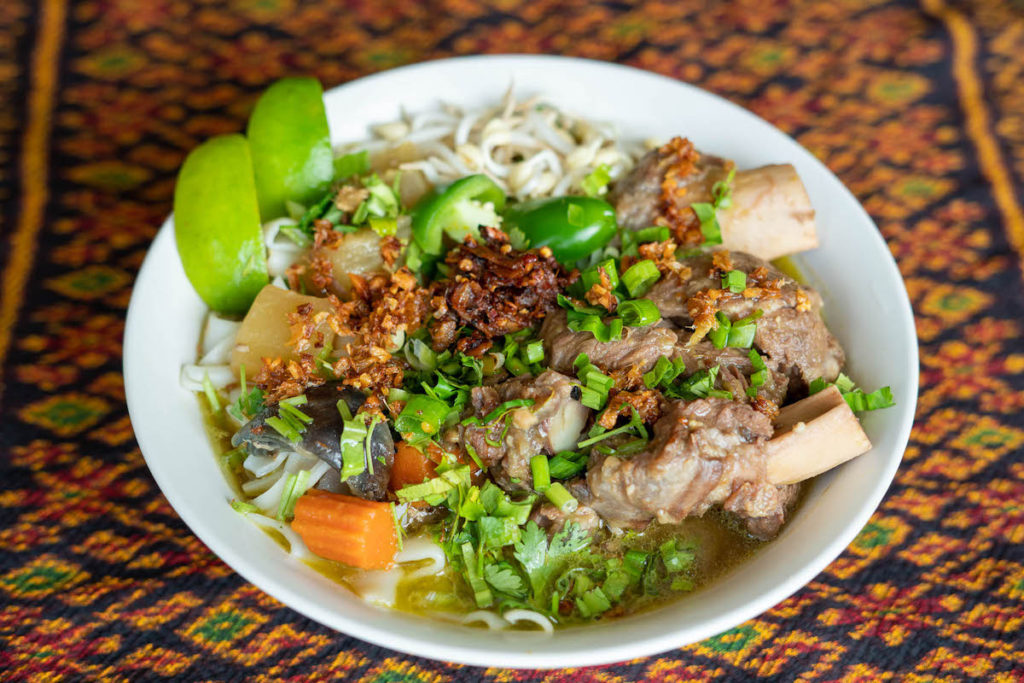
Read our Q&A with Theary to learn about traditional Cambodian cuisine, how she learned to cook, and more.
Please tell us about Cambodian food.
Our food is special because these foods are passed down through generations. There hasn’t been a lot of modern medicine in the country, but we have these ancestral, ancient ways of eating for our health. For example, we use galangal and garlic to help lower blood pressure. And the way we balance our dishes—the combination of carbs, vegetables, and herbs—it’s good for digestion.
Our baseline of our food starts out from fresh nature. At the heart of it is a paste called kroeung made from fresh lemongrass, kaffir leaves, turmeric, garlic, and galangal. Many people who think of lemongrass think of it as a scent or a tea, but they don’t think about eating it in soups and other meals. I slice the grass stem thin and smash it to release the oils, make it into a paste, so you get a wonderful aroma. This is the traditional way—no blending, because we didn’t have blenders. When I heat up the oil and add kroeung, it creates a great aroma that fills up the room.
Cambodian food is all about caramelization, and each person adding the toppings they want to get the right balance of salty and sweet. Take fried rice for example. It’s steamed rice with the kroeung paste. Then you top it with caramelized garlic, sliced ginger, and sauce, and you get so many layers of interest. It’s so attractive to your eyes, and nose, and mouth.
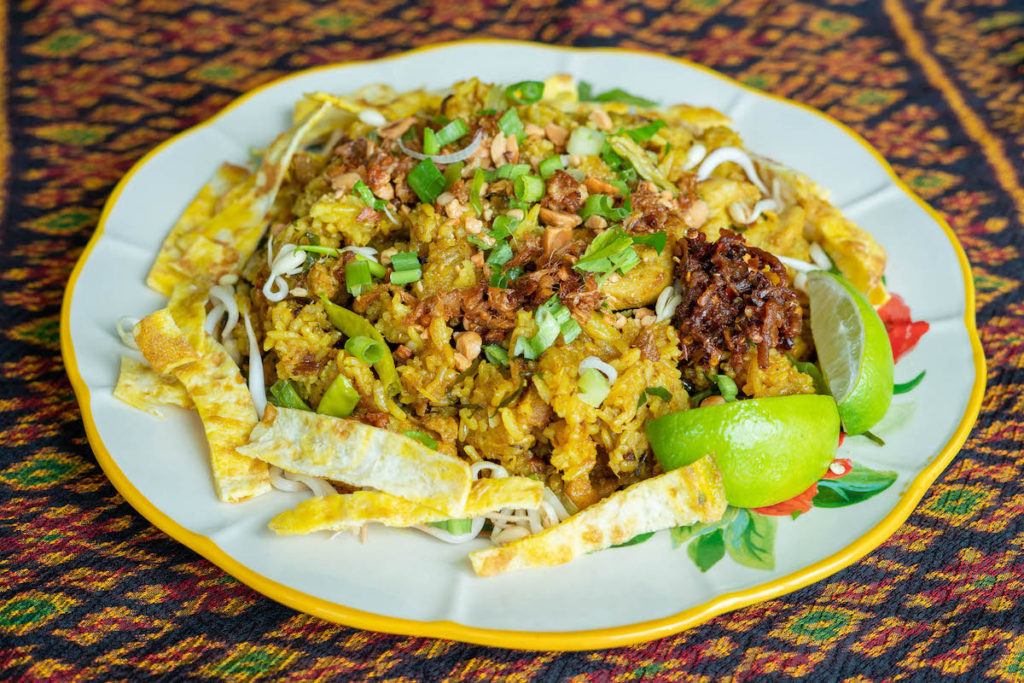
How did you learn to cook?
My mom was a chef. I didn’t like cooking because growing up I wanted more of my mom’s time, and it was always taken away from me when she was cooking for everyone. Same with my dad—he was a Buddhist priest, so their professions took them away from me. I didn't like how much time my mom spent cooking. When she cooked for the community center, for friends, I walked away. But I looked at what she had on the counter, and I noted all of it, took a photo in my mind of all the ingredients.
After my mom died, my childhood friend recruited me to cook for Khmer seniors to carry on the legacy my parents started in the late 80's to mid 90's. He wanted the Khmer seniors to have a place to go and socialize, and most important to enjoy the authentic Khmer foods that they loved when my parents were cooking for them. I still didn’t like cooking, but the seniors were saying that they liked my food, and it tasted like my mom’s, and reminded them of my mom, and they missed her. They said when they see me, it’s like seeing my mother, and it makes them happy. So I felt a commitment. And then I started to love cooking. What I love most about being a chef is being able to deliver happy moments and happy memories—being able to create that, so the rest of their day they feel happy and have memories of their family life.
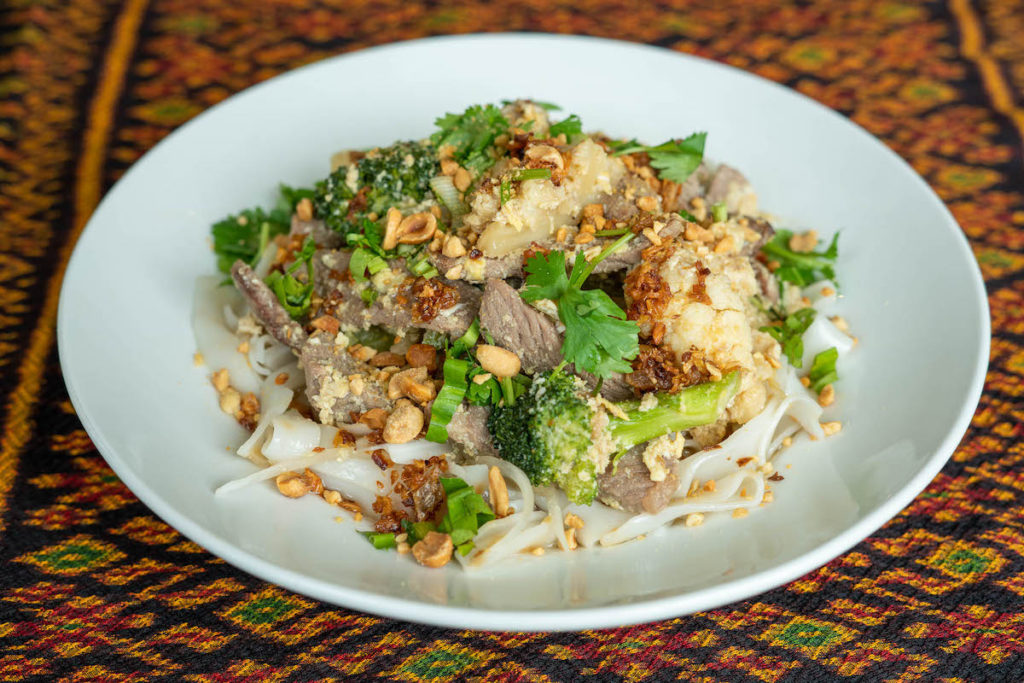
Tell us about starting your business, Theary Cambodian Foods.
Cooking at the community center helped me practice cooking in a commercial atmosphere, cooking for big crowds. I learned how to move and make things fast and in an authentic way.
I knew I wanted to have my own food business, but I didn’t know how to do it. I didn’t have the direction or the resources. My friend Liyu [now the owner of WUHA Ethiopian-American Cuisine] was at my house eating my chili oil, and she loved it. She said it had to be in stores and restaurants. She also told me about FIN. I joined FIN and took business classes with Ventures.
Before Spice Bridge, it was just my home kitchen, a few friends in my living room. I couldn’t see where my food could go. Now I see how it can go to be shared around the world. I’m ready! I feel excited, happy, ready.
Maybe my mom is looking out for me—it’s like she said, “Let's get you into cooking! And here’s your friend Liyu, and she’ll introduce you to FIN.”
My mom wanted to start a restaurant, but didn’t have the resources. Now I feel her dreams will be accomplished through me.
Visit Spice Bridge
Come by Spice Bridge to experience cuisine from Theary Cambodian Foods and other rotating vendors. We have takeout and outdoor dining available, and some vendors offer delivery options. See our full schedule.
Theary Cambodian Foods is open at Spice Bridge on Thursdays, Fridays, and Saturdays from 11 a.m. to 8 p.m
Contact Theary Cambodian Foods
- Website: theary-cambodian-foods.square.site
- Instagram: @ThearyCambodianFoods
- Facebook: @ThearyCambodianFoods
- Email: ThearyCambodianFoods@gmail.com
- Phone: (206) 201-9995

Meet Liyu Yirdaw, owner of WUHA Ethiopian-American Cuisine
We’re excited to introduce you to the businesses that offer cuisines from around the world at Spice Bridge, our new food hall! Today we’d like for you to meet the owner of WUHA Ethiopian-American Cuisine.
Growing up in Ethiopia’s capital city, Addis Ababa, Liyu Yirdaw loved to spend time with her mom in the kitchen.
“Everything she cooked has always had an exciting and wonderful taste to it,” Liyu said.
Inspired to study western cooking at culinary school, Liyu graduated at the top of her class. When she came to the United States 15 years ago, she was thrilled by the variety of different ethnic foods she found, and began experimenting with different flavor combinations.
“Food is an art for me, and I like to create mouthwatering bites by mixing flavors, spices, and herbs from different cultures, and also recreating dishes by adding or substituting ingredients,” Liyu said.
Liyu launched WUHA in October to offer a unique blend of Ethiopian and American foods, served more quickly than a typical Ethiopian restaurant meal.
We spoke with Liyu about her Spice Bridge menu, the meaning of “WUHA,” and her big plans for the business. Read our Q&A to learn more about this dynamic entrepreneur!
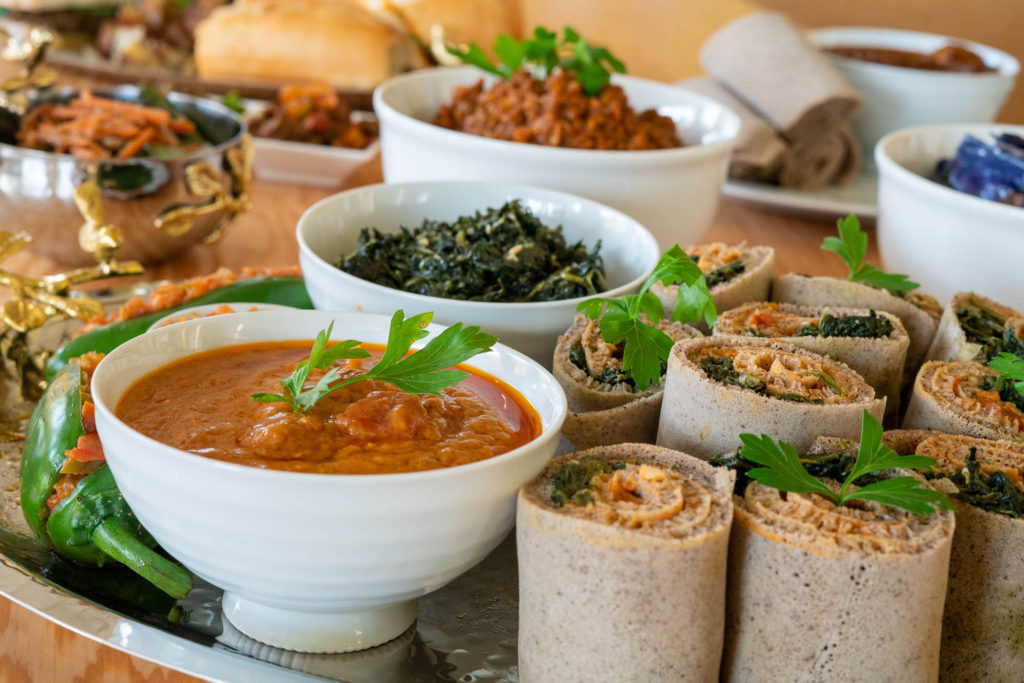
Please tell us about your business.
I offer customized food for people who have never eaten Ethiopian food before, people who like to experience new flavors, curious foodies, and for those who are used to eating American food and ready for a different take on it. We bring those two cultures together and let them inspire each other to complement one another. We also minimized some of the spiciness out of the Ethiopian food without sacrificing the taste of the food, sometimes just by simply cooking it longer. If people want to try Ethiopian food, but they aren’t ready for the full burst of flavors, then they can taste this. It’s not too spicy, but it’s spicy enough for it to be distinctively Ethiopian.
It’s also a fast experience. Most of the time when you go to an Ethiopian restaurant, there is a long waiting time, but we have quicker service. You can get in and get out quicker. Which makes it ideal for people who are short on time and want to grab and go. We also designed our menu items portion for 1-2 person servings which makes it convenient for solo dinners or for people who like to come in a group of two or more, as it allows everyone to have their own food, plate or to-go box, to eat out of. This also makes it safer and convenient for customers to stay in compliance with current COVID-19 guidelines. The portion size also makes it possible for people to eat and finish their food in one sitting instead of having leftovers, and carrying it around with their car smelling like food.
What makes your cuisine special?
What makes my cuisine special is that I cook it as if I would cook it for my family: with great care and love. If you like spicy food, but not too spicy, then you will get that taste in my cuisine. We serve both vegetarian and meat lovers, wheat and gluten-free injera, dessert with nuts, without nuts, and without butter, so everyone is welcome to come get the full taste without sacrificing the taste or flavors of the food.
We always go for the healthier version of everything—heart-healthy food with less fat. I use healthy oils like olive, grapeseed oil, or coconut oil depending on the food. I’m also trying to help people add vegetables to their diet. And we won’t sell things with too much sugar. We’re not planning to serve sodas; we have bottled water, coconut water and carbonated mineral water focusing on hydration and digestion, because we want to introduce healthy options.
Can you describe some dishes you offer at Spice Bridge?
We have beef and vegetarian injera rolls; injera is an Ethiopian flatbread, and I roll it with meat, vegetables, and sauces I make from scratch.
Our beef roast sandwich with an Ethiopian twist, served with oven roasted potatoes, is very popular.
We also have our already-famous dessert, WUHA’s baklava, made in house with an option of with nuts, without nuts, and with no butter for vegans.
We’re also planning all-day breakfast days, with both American food like pancakes and Ethiopian food like ful—and we’ll present things in a way that you wouldn’t expect.
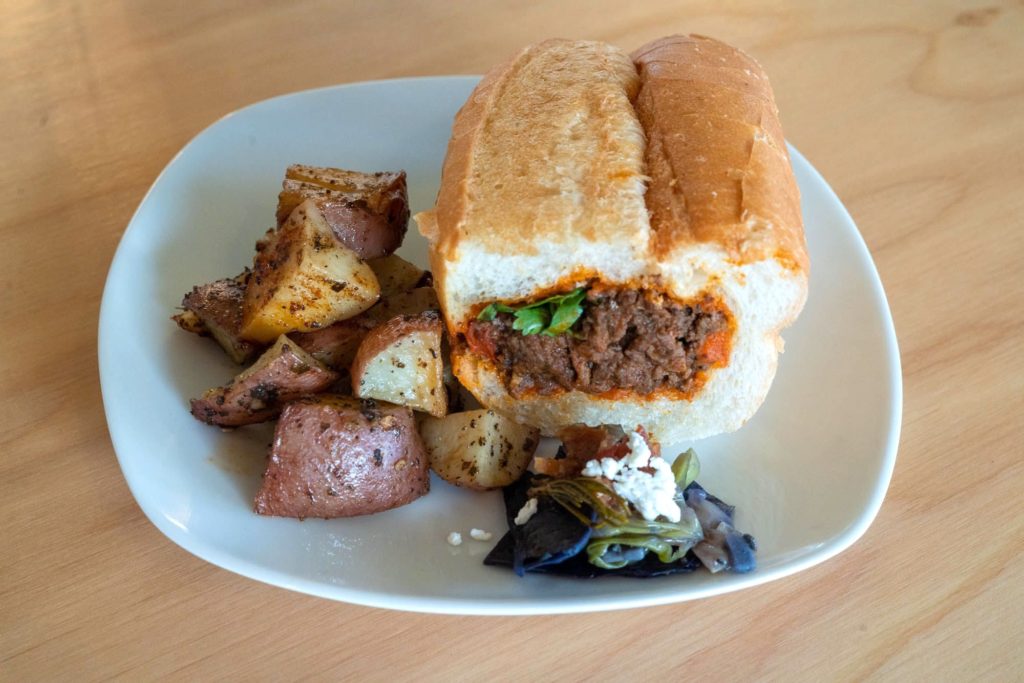
How did you choose your business name?
“Wuha” means “water” in Amharic, which is the national language of Ethiopia. Water is life. A person can live long without food, but cannot live without water more than a couple of days as more than 60 percent of the human body is water. Water is for everyone, and I want my food to be like that—I want for everyone to love and enjoy it. I want WUHA and its future products to go worldwide, and that’s how and why I named my business WUHA.
What challenges have you encountered trying to establish your business, and how have you overcome those challenges?
I’ve always wanted to have a food business, but I was afraid. When you have a food business, there is more to it than just cooking. There is accounting, managing your budget and people, menu making, logo and business card designing, licensing, state and city regulations and guidelines to follow and so much more to the business. Also, at the beginning, I started with a partner who couldn’t be in the business anymore for a variety of reasons. It was sad for me, and hard to lose my partner. And I went from sharing responsibilities to having to do everything as one owner.
COVID has also been a big challenge. For one thing, the way we think about food businesses changed. Also, I am a nurse, and I had to adjust with that work.
My focus shifted, but I’m back on track now. Being with FIN, I am really hopeful and I believe I will get there with no problem because I’m working with a group of people who want me to succeed, and who are there for me. The FIN staff have helped me, keeping me on track and focused. When I have a question or something is hard, I have someone to ask, and someone who can share ideas and consult.
What is your dream for your business?
Opening at Spice Bridge is a first step for me, and I have big plans for WUHA. This is the beginning of it—my plan is to expand and franchise WUHA around the world. I also want to start packaging foods. I want people to find my food in every grocery store so they can heat it up and enjoy it anytime at home. I want it to be accessible. I also want to start our WUHA’s mixed spices line for people who want to try and cook my food at home.
Is there anything else you want people to know?
The main ingredient in my food is love. I love my mom’s food, and I especially want to eat it after a long day. All I want to do is go home and eat my mom’s food, dine with my parents. I think a lot of people can relate to that, and I want people to get that warm feeling when they eat my food. When they come, I want them to not only get that good food, but to also to feel loved and taken care of and to feel the good energy that they could feed off of. I want my food and my service to make their day and give them the comfort they need—that’s very important to me. I’m coming from a really good place, and I want to deliver that feeling to people. I want them to have an unforgettable great experience.

Visit Spice Bridge
Come by Spice Bridge to experience food from WUHA and other rotating vendors. We have takeout and outdoor dining available, and we’re also working on delivery options—stay tuned!
WUHA is open at Spice Bridge on Tuesdays and Wednesdays from 11 a.m. to 8 p.m., and on Sundays from 10 a.m. to 5 p.m.
Contact WUHA
- Website: wuhacuisine.square.site
- Email: wuha.ethiopian.cuisine@gmail.com
- Phone: (206) 474-0898
- Facebook: @WUHAcuisine
- Instagram: @WUHAcuisine

Meet Jazze’s owner Nasrin Noori
We’re excited to introduce you to the businesses that offer cuisines from around the world at Spice Bridge, our new food hall! Today we’d like for you to meet the owner of Jazze’s.
Since she was a young girl growing up in Afghanistan, Nasrin Noori loved being in the kitchen, where she would challenge herself to craft delicious meals from limited ingredients. Nasrin moved to the U.S. with her family at age 11, and by the time she was a teenager, relatives and friends knew how creative she was in the kitchen. They enlisted her help cooking for big events, and Nasrin was also responsible for preparing dinners for her family of 10.
In her late teens, Nasrin became interested in nutrition, and started learning about the U.S. food system and the benefits of organic foods. She got certified as a health coach, and eventually opened Jazze’s to offer healthy Afghan fusion food prepared with organic, local ingredients. Her menu caters to a variety of dietary needs and preferences, and includes paleo, vegan, and gluten-free options.
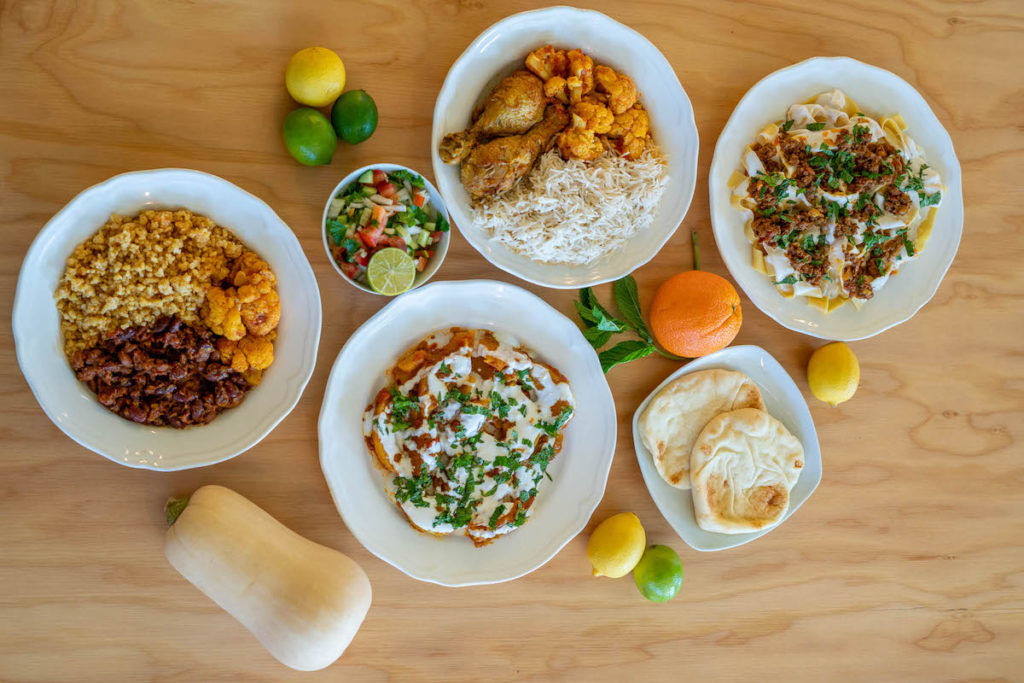
Read our Q&A with Nasrin to learn about her seasonal menu, how she balances raising four children with starting a new business, and her dreams for Jazze’s.
How did you choose "Jazze's" for your business name?
Picking the name for my business was probably the easiest part of becoming an entrepreneur. My children are my number one inspiration for most things that I do. I’m a blessed mother to four incredible little people. My oldest son's initials are J.A., my second son's is Z., my daughter's is also Z., and my youngest son's is E. All their initials combined creates Jazze’s.
Can you describe your cultural heritage and how it influences Jazze's cuisine? What elements of Afghan cuisine are incorporated into your menu?
I would say that my cultural heritage is Muslim-Afghan-American. The biggest part of my Afghan roots is the food. Afghan food has been a central part of my upbringing regardless of where we've lived—the food was a consistent part of my life. We moved to the States before my 12th birthday. I've lived more than half my life in the States, but my connection to Afghan food is very much a big part of my life still.
When I look at my children, their only connection to their Afghan side is the food and hospitality of Afghan culture. Food is a way that my children are learning about my upbringing and my childhood, and they compare it to that of their father, who's African-American. The kitchen is a big part of our family's connection; both my husband and I are somewhat foodies, and we are very much health-conscious individuals. We care about what we put in our body and what we bring in our home to feed our family, and this same care goes into what we offer at Jazze's.
A lot of different elements of Afghan cuisine are incorporated at Jazze's, but one of the most important elements for me is offering a seasonal menu. This is how Afghans traditionally prepared meals and dishes—based on what was available during that season. For the past 20 years, I've been learning about health and nutrition and how it impacts your mental and physical wellbeing, and as a certified health coach I understand the importance of eating clean, fresh, and seasonal.
Please describe a couple of the dishes you offer at Spice Bridge.
Kabili Pilau is probably one of the best known Afghan dishes. Some may even say it’s the national dish of Afghanistan. It’s long grain rice served with lamb or chicken and topped with carrots, raisins, and cardamom spice. I jazz this dish up a bit by adding almonds, pistachios, cranberries, and fresh orange zest. It’s been a favorite in my home for many years, especially in the fall months with all the beautiful fall colors topped on the lamb and rice. It’s been a tradition at our Thanksgiving dinner.
Burani Kadu is squash with yogurt. This is a very much a seasonal dish, as are most Afghan dishes. This dish can be made with any variety of squash. The squash is cooked in a delicious onion, garlic, and tomato sauce and topped with a garlic yogurt sauce, garnished with mint. Burani can be served with warm bread or rice.

What challenges have you encountered trying to establish your business? How have you overcome those challenges?
I would say enough time, enough finances, not having any prior knowledge of running a business and an up-to-date knowledge of technology are a few of the challenges. I’m not sure if I have overcome any of them completely—it’s work in progress and a lot of trial and error. I think that in today’s society, time is a constant balancing act, especially when you are a parent. For the rest of the challenges I’m incredibly blessed to have FIN on my side. The amazing individuals at FIN, who all go above and beyond their job titles and wear multiple hats to help me achieve my goals, and dreams of being a successful entrepreneur.
What is your dream for your business?
I have a lot of big dreams for Jazze's. I am very hopeful despite the pandemic; I am hoping that things will go back to normal. I want Jazze's to be a place where people can come and feel at home and experience the Afghan hospitality and enjoy clean nutritious meals with their families and feel confident about what they're eating. I'm envisioning Jazze's having a formal dining area upstairs, and the downstairs is more of a laidback cafe with local artists performing, poetry slam nights, speakers on various topics—so not only are you filling your bellies with awesome food, but you're fulfilling your soul with knowledge and inspiration.
Visit Spice Bridge
Come by Spice Bridge to order food from Jazze’s and other rotating vendors. We have takeout and outdoor dining available, and we’re also working on delivery options—stay tuned!
Jazze’s is open at Spice Bridge on Thursdays, Fridays, and Saturdays from 11 a.m. to 8 p.m.
Contact Jazze’s
- Email: jazzesfusion@gmail.com
- Phone: (206) 407-4767
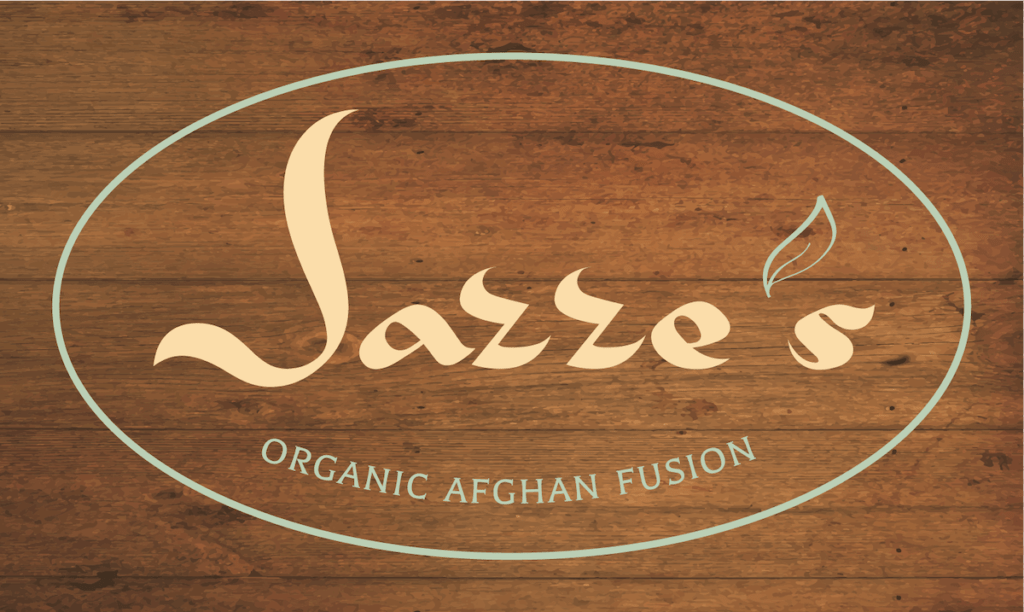
FIN entrepreneurs make meals for communities affected by COVID-19
FIN entrepreneurs are contributing their time and skills to make tasty, healthy meals for families and older adults who need them. Check out our photo album, and watch a video featuring our first meal's lead chef, Naija Buka owner Lilian Ryland:
We're now cooking up 600 hot meals each week. Our partner Linda Croasdill at the City of SeaTac Senior Program reports, "The meals have been a big hit and everyone would like to give you and your support team a great big air hug and a really big smile."
We are excited to share that we are collaborating with the American Heart Association to provide hot meals and support our Food Business Incubator entrepreneurs in the process. American Heart Association’s support has allowed us to expand our meals and add health education components to the work. This summer we will work together to support seniors living with food insecurity and establish deeper connections for the community.
Huge thanks to everyone who’s helping to nourish our community as we face this challenge together. We're grateful to our individual donors, who have collectively contributed more than $2,500. We're also thankful for:
Our in-kind supporters
- Tilth Alliance is providing fresh, locally grown produce weekly
- Macrina Bakery is supplying wonderful baked goods weekly
- Project Feast is donating key ingredients, cooking dishes, and sharing much-needed kitchen facilities
- Des Moines Area Food Bank is supplying dried beans and other legumes
- Food Lifeline is contributing staple food ingredients weekly
- The Storehouse Covington Food Bank has contributed ingredients
- FIN entrepreneurs, Incubator program manager Kerrie Carbary, and many of Kerrie's neighbors have contributed ingredients
- Cheri Mayer gave our kitchen and delivery crews homemade masks to support health and safety
Our chefs, meal packers, and delivery drivers
- FIN entrepreneurs including Naija Buka owner Lilian Ryland, Mamá Tila owner Ofelia Anorve, Monique's Hot Kitchen owner Monica Wachira, Seatango owners Monica di Bartolomeo and Ariel Firpo, and Soozveen Mediterranean Catering owner Sheelan Shamdeen
- Community volunteers including Liyu Yirdaw, Theary Ngeth, Khadija Yusuph, Mwana Moyo, Batulo Nuh, and FIN Steering Committee Co-chair Ehler Win
- Global to Local staff members including Abdi Hussein, Jonathan Sugarman, Katie Behrends, Deeqa Mah, Roda Sugulle, Kara Martin, Kerrie Carbary, and Denise Miller
Our community partners distributing meals
- Somali Youth & Family Club
- Congolese Integration Network
- Somali Health Board
- City of SeaTac Senior Program
- Catholic Community Services
- Living Well Kent
Get involved
You can make a donation at bit.ly/FINmeals, or email Kerrie if you’d like to help in another way: kerrie@foodinnovationnetwork.org
Keerai Farm: Connecting With Agricultural Traditions and a Diverse Community
At Keerai Farm in Enumclaw, Victor Anagli and Deepa Iyer are building on their families’ farming and cultural traditions. Victor’s family has been growing food for generations in his birthplace, Denu village in Ghana. Deepa’s ancestors lived among rice fields in southern India, and her family has strong cooking traditions.
"I want to rescue my cultural traditions and those of my friends and collaborators," Deepa said. "We all have deep cultural traditions related to food and farming, yet in our industrial system, many of us lose those traditions in exchange for industrially produced food that often has negative impacts on the land, water, and the people who work to grow, process, and sell the food. Not to mention that our children become addicted to packaged and processed food, to eating on the run out of a paper bag or box, rather than having a way of life that allows us time to grow the food, harvest together, celebrate the bounty, give thanks together, share meals, and lift up our ancestors."
An engineer by training, Victor left his corporate job to get back to his agricultural roots. Deepa has worked as a naturalist and food systems educator, and is currently a program coordinator with IRC’s New Roots program—FIN’s partner in organizing Tukwila Village Farmers Market and Namaste Farm Stand. In addition to supporting the Namaste Garden and Namuna Garden growers who sell food at our markets, Deepa has also shared some of Keerai Farm's abundance at Tukwila Village Farmers Market.
Deepa and Victor bought their 21-acre property in 2018, and they’re already growing some of the same foods their ancestors ate, such as roselle, bottle gourds, peanuts, and okra. The couple take produce requests from community members, including Deepa’s mother’s Indian community and Tukwila Village Farmers Market customers. They're experimenting with small greenhouses and organic agricultural techniques as they learn how to grow these culturally significant foods in the Pacific Northwest’s climate.
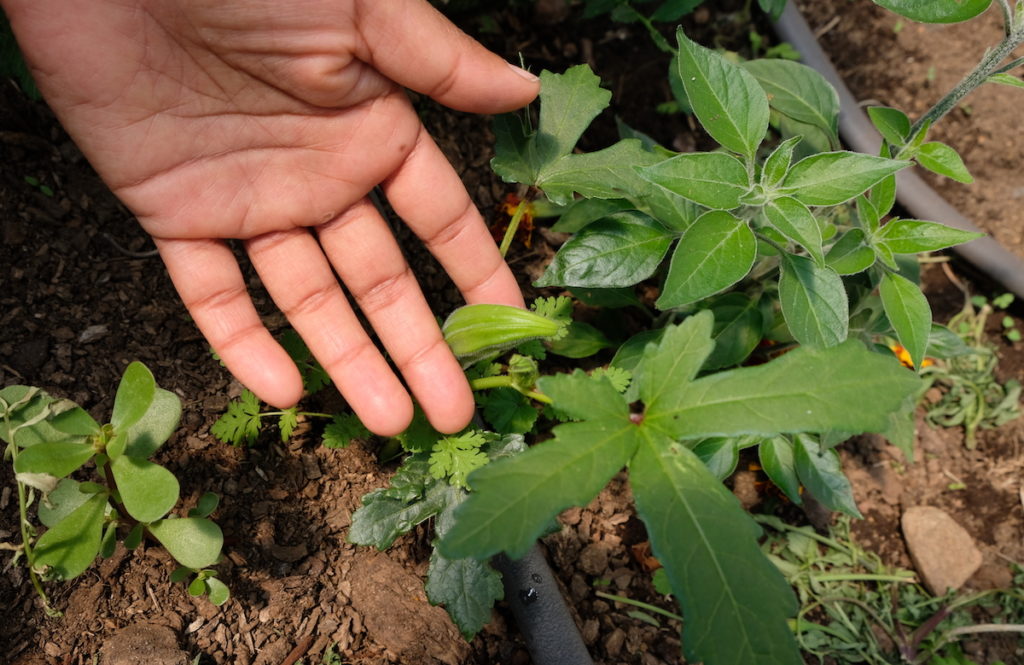
Growing community
"Keerai Farm is our dream: living life close to the land, connected to the Earth, caring for her each day we wake up, seeing our children run free and breathing fresh air, eating real food coming straight from the soil and grown with love and care," Deepa said.
Deepa and Victor’s children are already well acquainted with farm life. Their 15-year-old son, Devon, loves tinkering with machinery, and helped install their irrigation system. He’s also creative in the kitchen, and surprised their family with tasty popsicles made from homegrown berries he’d collected. Their 3-year-old daughter, Samika, has learned to identify many of the plants they grow, and loves riding on their tractor as they cut grass.
Victor and Deepa want to share the experience of farming with other families--particularly those who have a hard time accessing land because of displacement or economic reasons, or because they don't feel socially or physically safe living in a rural area.
"This is why we focus our work on connecting with BIPOC (Black-indigenous-people of color) families—because in King County there is diversity, but many folks of color do not own land and/or do not feel comfortable or have a space that feels welcoming to come and connect to the land," Deepa said. "We hear this from so many people who come to visit: 'We would love to live this way but we are not comfortable.' Well, if we could live in community, then we could keep each other safe and inspired."
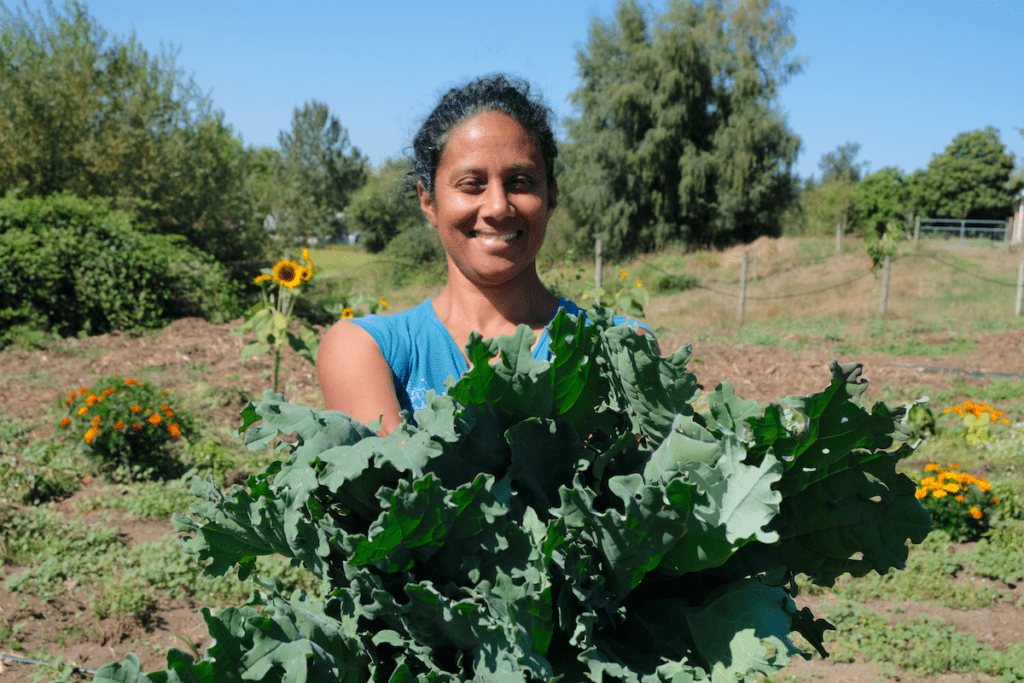
Deepa and Victor have been overwhelmed by positive feedback from community members who have visited Keerai Farm. Some have already been inspired to change their eating habits.
"Every time people come here, they taste the produce and say that it tastes different from the stores. That is a hell of a testament," Victor said. "A group came to visit last week and harvested produce and cooked a meal in our kitchen, and then told us that that experience made them want to eat more fruits and vegetables and cook more for themselves."
Victor loves sharing not only fresh food, but also knowledge about organic farming that has been passed to him down through generations.
"I believe growing food authentically without chemical aid is the way to do it. Food is medicine. Food is a healer. If you keep pumping it with fertilizers, that defeats the purpose," Victor said. "It is important that we all know this, for this knowledge to be passed down—the actual doing part, not just reading a book. You have to go through the process with somebody. It is vitally important to share that knowledge."
In addition to inviting community to come farm, Victor and Deepa are organizing events on their property. In June, 90 people spent a weekend practicing capoeira, camping, and enjoying the land at the “Grounded in Freedom” event that Keerai Farm hosted. Deepa and Victor plan to hold more events combining food, community, and healing arts such as yoga.
"Keerai Farm is a place of healing, a place where you are able to come and feel one with nature," Victor said. "My vision for the future: a lot of people, like-minded folks who believe in authentic food, building community, and just being here now, being present together."
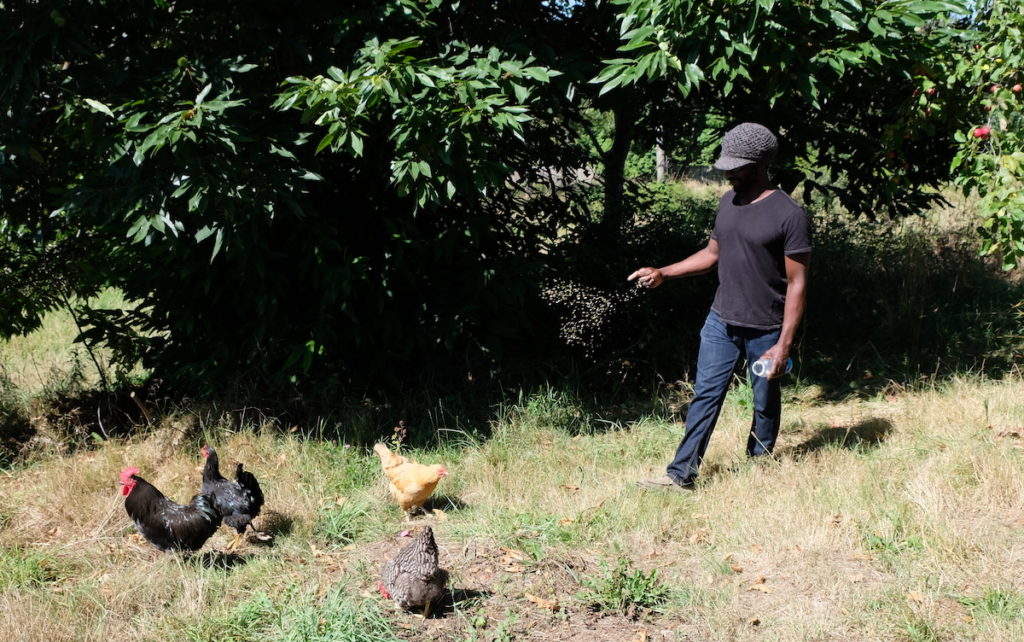
Help harvest at Keerai Farm
Deepa and Victor invite you to experience and help farm their land—and take fresh produce home. You can email Deepa at keeraifarm@gmail.com to set up a visit. It’s harvest season—a great time to be on the farm!
Food Is Medicine at Laura’s Garden
As an acute care nurse, Laura Vogel helps patients who have heart and kidney diseases—conditions she connects to poor diets.
“I see the effects of processed food every day. And it’s not just diabetes—it’s the inflammatory state that food can potentially put you in. You’re just so much more susceptible to disease, and illness, and poor healing if you do get sick,” she said.
Laura believes that eating a diversity of fresh foods can help prevent disease. She’s working to spread the word, and also to share her homegrown produce with her Tukwila neighbors.
“I want to help the community get healthy and not have to come see me at Harborview!” she said. “Food should be our primary medicine—not pharmaceuticals.”
A thriving home garden designed with permaculture in mind
You may have met Laura at Tukwila Village Farmers Market this season. When her schedule allowed, she set up the Laura’s Garden farm stand to sell fresh vegetables, fruits, and herbs grown in her yard just a few blocks from the market.
Embracing permaculture—an agricultural design system modeled on nature—has enabled Laura to cultivate an abundance of produce on a residential property.
“It’s about permanent agriculture, and growing food systems that are sustainable and economical, and better for the environment,” Laura said.

Permaculture rejects monocrops, the modern practice of growing large amounts of a single plant. Natural food systems are diverse, and so Laura’s garden is incredibly varied. Among her edible plants are squash, tomato, asparagus, tomatillo, beans, peppers, chard, gherkins, fennel, sorrel, ginger, tea, hops, tulsi, turmeric, bay leaf, parsley, thyme, oregano, and garlic. She also grows almond, fig, apple, pear, peach, and plum trees, as well as flowers that support pollinators.
It’s easy to spot other elements of permaculture on Laura’s property: a rainwater irrigation system keeps her plants healthy without using city water; wood chip mulch reduces evaporation, suppresses weeds, and conditions soil.

Laura is completing a certificate in permaculture design, and hopes her garden can one day become a permaculture demonstration site to provide inspiration to other gardeners.
“You can do a lot with a little, and I want to show that to other people, so they can also grow a lot of food even in a little space,” she said. “And if you do grow more than you can eat—which happens very quickly—then you can share it.”
Get involved
Participating in the farmers market this year, Laura realized that she didn’t have enough spare time to regularly harvest and prepare her produce for sale. Still, she’d love to share her food with people who will enjoy and benefit from it. Now she is looking for a community member who’d like to harvest her produce and share it with the community.
“It would be a dream come true if someone came to harvest weekly, and either donated to the food bank or set up their own stand,” she said. Laura envisions a learning opportunity for someone interested in permaculture, and a potential income opportunity if that person wanted to sell the food locally.
Would you like to partner with Laura to share her food with our community? Get in touch with her at vogel.laura.k@gmail.com.

New Roots: Building Thriving Gardens and Communities
“I am very lucky -- my happiness knows no bounds," Krishna Biswa says while walking among rows of healthy lettuce, robust basil, and vibrant beets. His close-knit family and thriving garden plots are among his greatest joys.
“I have a beautiful granddaughter who’s 14 months old," he continues, beaming. "She visits the garden sometimes, and she loves snap peas and cucumbers.”
Krishna’s parents, siblings, and children also enjoy the fresh, tasty produce he grows at Namaste Community Garden and Namuna Garden in Tukwila. For their family, growing and sharing food is a beloved tradition.
Krishna recalls his parents producing corn, greens, rice, cardamom, and oranges in Bhutan, their country of origin. After resettling in South King County as refugees in 2010, they've have been able to garden again thanks to the IRC New Roots program.
New Roots builds on the agricultural experience of many refugee and immigrant families by providing access to land, materials, and education for program participants to grow healthy food. Through a partnership with landowner St. Thomas Catholic Church, IRC began connecting resettled refugees with Namaste Community Garden plots in 2010.
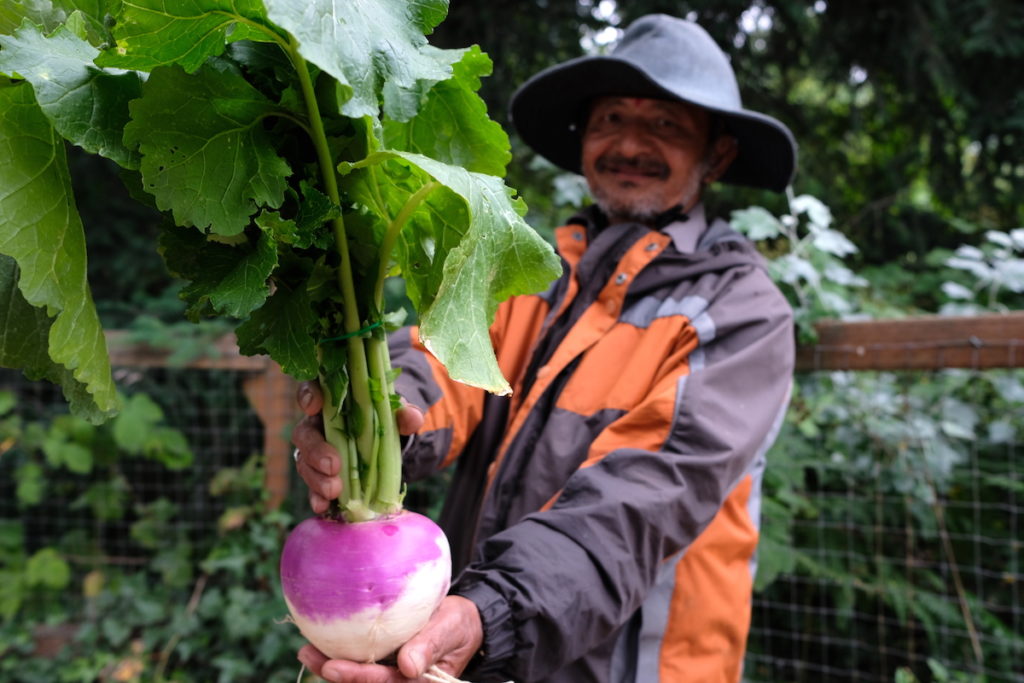
“We are very lucky to have this garden because we are able to practice our gardening traditions, and the produce we grow here is very good,” says Krishna, who started tending a plot at Namaste Community Garden in 2012. “It’s supporting our family and reducing grocery expenses.”
Krishna’s parents and brother also tend plots at Namaste Community Garden, and they love exchanging advice for growing organic food with their fellow gardeners, families from Bhutan and Myanmar.
“I have a lot of friends in Namaste Garden,” Krishna says. “They have their own way of growing, and sometimes I learn from them, and sometimes they learn from us.”
Namuna, an exemplary garden

Food Innovation Network partnered with New Roots to start selling Namaste Garden’s produce to community members at Tukwila Village in 2018. That summer, two customers mentioned to New Roots staff member Kamal Adhikari that they had a big backyard in Tukwila that they’d happily make available to growers. Within months, Krishna and four other gardeners were transforming the expansive lawn into a flourishing agricultural space.
They called it Namuna Garden, meaning Example Garden, Kamal explained. It’s an example both of community members sharing their land with growers, and of the excellent produce that can be grown in such spaces.
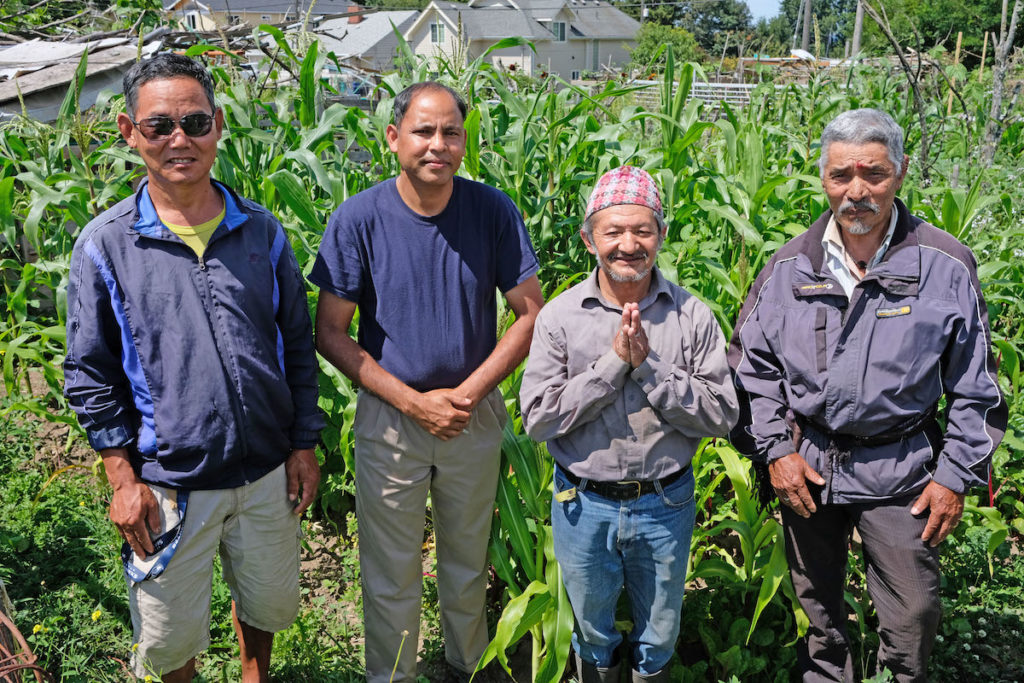
The five growers who tend Namuna Garden are all graduates of New Roots’ Micro-Producer Academy, an eight-week program that teaches budgeting, crop planning, irrigation, and other essential skills. They’re putting their knowledge to work this season at the new Tukwila Village Farmers Market, where they operate booths to sell produce from both Namaste Community Garden and Namuna Garden.
Their produce has been so popular that they sometimes sell out of items within an hour of the market opening. No problem – a grower will head a few blocks to the gardens to harvest more. Food doesn’t get much fresher or more local than that.
“We love bringing good seasonal vegetables to the farmers market,” Krishna says. “We’re happy to see a lot of diverse people there, and to meet customers.”
The gardeners hope that sharing their produce can help spread some of the happiness that they've enjoyed while growing it.
Meet the growers
Namaste Community Garden and Namuna Garden growers sell produce at Tukwila Village Farmers Market on Wednesdays from 4-7 p.m. Come out to meet them, along with Wakulima USA gardeners and other local food producers. And keep an eye on our website for more spotlights on local growers!
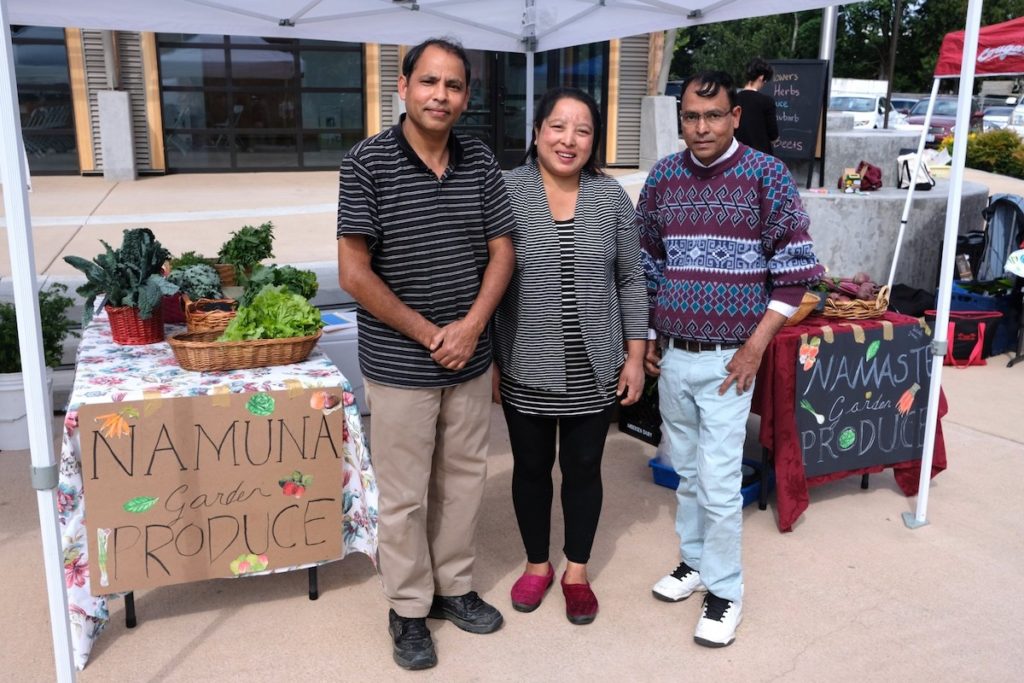
Wakulima USA Supports Local Farmers and Grows Hope
David Bulindah is one of the local food growers you’ll meet at the new Tukwila Village Farmers Market. Together with Dickson Macharia, he co-founded Wakulima USA, a nonprofit that helps immigrants connect with agricultural land and grow crops in South King County.
Wakulima is Swahili for farmers; the organization's name reflects their initial group of eight food growers who are immigrants from east and central Africa.
“We are trying to encourage our farming practices because many of us were farmers in our home countries,” David said. “When we come here, it’s something we find we can be able to do, and that we do out of passion.”
Wakulima USA focuses on growing culturally relevant food – nutritious vegetables that David and Dickson grew up eating in Kenya. Some plants like amaranth and spiderplant are rare in the Seattle area, while others such as kale and collard greens are more common.
David takes inspiration from his mother, an urban farmer in Kenya’s Rift Valley.
“We were too poor to own land, and we lived in the city. But my mother would go up on the side of the road and plant amaranth, corn, and other things. So we were able to survive and get something to eat,” he said.
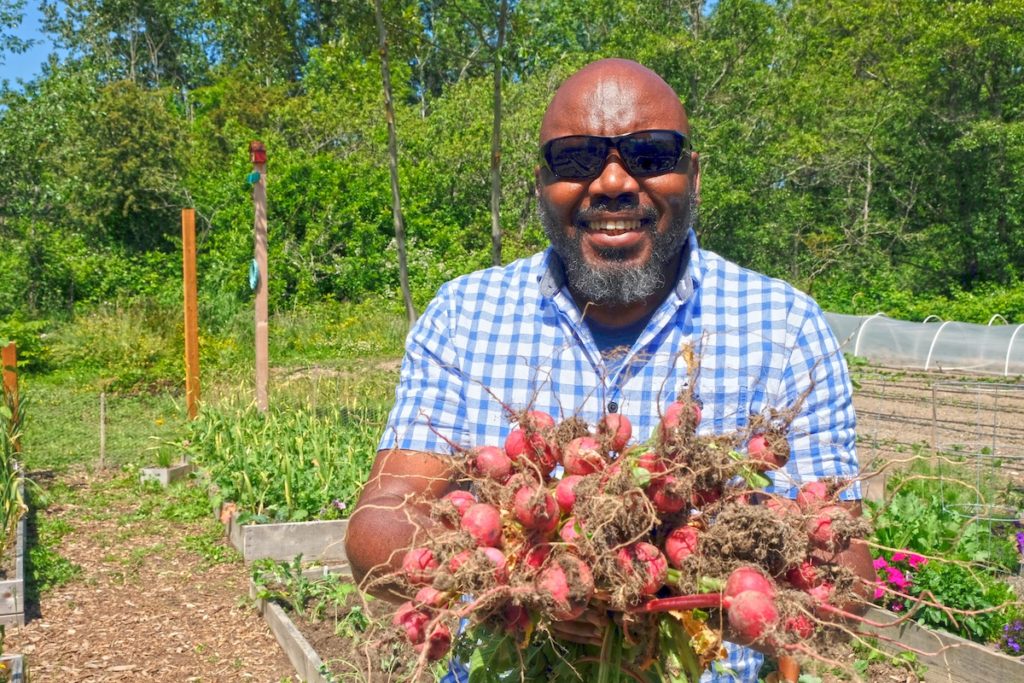
“It gives you a sense of hope”
Now a mental health therapist, David sees farming as a source of nourishment for not only the body, but also the mind.
“It’s therapy for me,” he laughed. “We put the seeds in the ground, and every day we have to water them, and we see how they’re coming up. And then you wake up, you see a tomato there -- it gives you a sense of hope.”
He loves to share the practice of gardening with others, including his children and nieces.
“I bring them here to see how to plant the crops -- because most kids don’t understand where food comes from,” he said.
David’s wife, Irene, agrees that it’s important to pass along farming knowledge to the next generation.
“People need to learn about farming. We kind of walked away from it, but there’s now a big new push to know where this food is coming from. It’s hard to know what’s in it when it’s done by somebody else, somewhere miles away,” Irene said.
For Irene, the flavors of fresh produce are an added benefit: "There's a big difference when you grow your own food. You think it’s a cliché, but the taste is different straight from the garden.”

Finding space to grow
Locating agricultural land has been Wakulima USA’s biggest challenge. They reached out to local organizations, and Highline Urban Agricultural Garden helped them connect with a plot at the City of Des Moines’ Sonju Community Garden. Wakulima USA also works land in Kent thanks to World Relief Seattle.
Earlier this year, Wakulima partnered with Highline, King Conservation District, and FIN to present a workshop on farming in King County. Turnout was great, and more than 30 growers have asked Wakulima USA for support to start growing food in our region. The growers are on a waitlist as the organization works to locate more land.
One creative solution Wakulima USA came up with is collaborating with local property owners.
“We're trying to find senior citizens who have space on their property, who used to love gardening, and who can’t do it anymore. We would go there and volunteer, and clean it up, and put in a small community garden,” David said.
As Wakulima USA grows little by little, they have a grand vision for the future: a 20-acre farm with a research center where they would work with scientists to study the nutritional and medicinal values of crops like amaranth. They also envision an on-site restaurant that would give visitors a true farm-to-table experience.
For now, David and the other Wakulima USA farmers are excited to share their delicious, nutritious produce with community members at Tukwila Village Farmers Market.
Connect with Wakulima USA
Are you a property owner who's interested in working with Wakulima USA to build a community garden on your land? Are you looking for opportunities to get involved in community farming? Contact David and Dickson at wakulimausa@gmail.com.
Meet Jalissa Horton, Owner of Chef Jalissa Culinary Co.!
With family roots in the American South, Jalissa Horton acquired a taste for soul food as a child. By age 13, Jalissa was preparing full-course meals for her family, and she developed her love of cooking making family recipes passed down through generations. Jalissa’s mother nurtured her passion by allowing her to turn their home into a weekend restaurant for family, friends, and co-workers.
In high school, Jalissa learned cooking fundamentals at a culinary vocational program, and then received a scholarship to the prestigious College of Culinary Arts at Johnson & Wales University. After earning her degree, she studied Italian cuisine at the Florence University of Arts School of Culinary Arts in Italy.
 A new member of FIN’s Food Business Incubator, Jalissa is continuing her culinary journey through her business, which specializes in scrumptious food based on fresh, in-season local ingredients.
Check out Chef Jalissa’s website, and read our Q&A with her:
A new member of FIN’s Food Business Incubator, Jalissa is continuing her culinary journey through her business, which specializes in scrumptious food based on fresh, in-season local ingredients.
Check out Chef Jalissa’s website, and read our Q&A with her:
Tell us about your business.
We create products for fellow “foodies” who live for delicious food and love unique culinary experiences.What makes your business unique?
We present a fusion of Southern American cuisine and international spices to create a unique experience. I take pride in making everything from scratch, using authentic and natural ingredients for all dishes.What inspired you to start this business?
I started this business because I love to cook for others -- my food is authentic and made with love. I have spent my entire career in the restaurant industry. I live, eat, and breathe food. It’s not a hobby for me, but a way of life.
